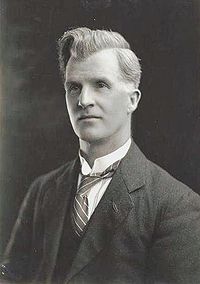James Scullin Politician
James Henry Scullin (18 September 1876 – 28 January 1953) was an Australian Labor Party politician and the ninth Prime Minister of Australia. Scullin led Labor to government at the 1929 election. The Wall Street Crash of 1929 transpired just two days after his swearing in, which would herald the beginning of the Great Depression in Australia. Already in a weak political position, the economic crisis would prove overwhelming for Scullin, with interpersonal and policy disagreements causing a three-way split of his party that would bring down the government in late 1931. Despite his chaotic term of office, Scullin remained a leading figure in the Labor movement throughout his lifetime, and served as an éminence grise in various capacities for the party until his retirement in 1949.The son of working-class Irish-immigrants, Scullin spent much of his early life as a laborer and grocer in Ballarat. An autodidact and passionate debater, Scullin would join the Australian Labor Party in 1903, beginning a career spanning five decades. He was a political organizer and newspaper editor for the party, and was elected to the House of Representatives first in 1910 and then again in 1922 until 1949. Scullin quickly established himself as a leading voice in parliament, rapidly rising to become deputy leader of the party in 1927 and then Leader of the Opposition in 1928.Winning a landslide election in 1929, events took a dramatic change with the crisis on Wall Street and the rapid onset of the Great Depression around the world, which hit heavily indebted Australia hard. Scullin and his Treasurer Ted Theodore responded by developing several plans during 1930 and 1931 to repay foreign debt, provide relief to farmers and create economic stimulus to curb unemployment based on deficit spending and expansionary monetary policy. Although the Keynesian Revolution would see these ideas adopted by most Western nations by the end of the decade, in 1931 such ideas were considered radical and the plans were bitterly opposed by many who feared hyperinflation and economic ruin. The still opposition-dominated Senate, and the conservative-dominated boards of the Commonwealth Bank and Loan Council, repeatedly blocked the plans.With the prospect of bankruptcy facing the government, Scullin backed down and instead advanced the Premiers' Plan, a far more conservative measure that met the crisis with severe cutbacks in government spending. Pensioners and other core Labor constituencies were severely affected by the cuts, leading to a widespread revolt and multiple defections in parliament. After several months of infighting the government collapsed, and was resoundingly defeated by the newly formed United Australia Party at the subsequent 1931 election.Scullin would remain party leader for four more years but the party split would not be healed until after Scullin's return to the backbenches in 1935. Scullin became a respected elder voice within the party and leading authority on taxation and government finance, and would eventually play a significant role in reforming both when the ALP returned to government in 1941. Although disappointed with his own term of office, he nonetheless lived long enough to see many of his government's ideas implemented by subsequent governments before his death in 1953.
Search
Office holder
| governor general | |
|---|---|
| monarch | |
| office | Member of the Australian Parliament for Yarra Member of the Australian Parliament for Corangamite |
| party | |
| successor |
James Scullin on Wikipedia
External resources
- http://adb.anu.edu.au/biography/scullin-james-henry-8375
- http://archive.treasury.gov.au/documents/1846/PDF/09_James_Scullin_depression_treasurer.pdf
- http://dro.deakin.edu.au/eserv/DU:30018358/robinson-australianclass-2008.pdf
- http://electionspeeches.moadoph.gov.au/speeches/1928-james-scullin?highlight=scullin
- http://electionspeeches.moadoph.gov.au/speeches/1931-james-scullin?highlight=scullin
- http://mildenhall.moadoph.gov.au/photos?sort_order=asc&search=scullin&from=1+Jan+1921&to=31+Dec+1935&showing=53
- http://primeministers.naa.gov.au/primeministers/scullin
